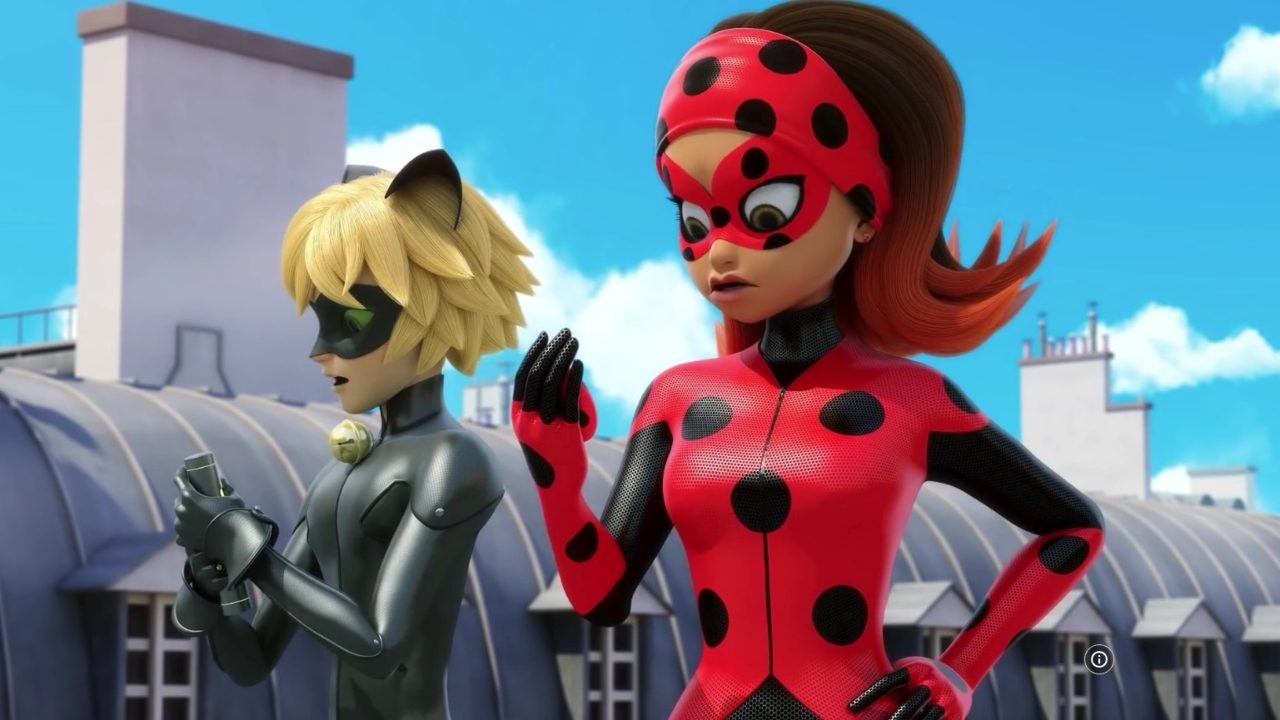
MIRACULOUS: TALES OF LADYBUG AND CAT NOIR Promotes Unhealthy Romantic Behavior
By Movieguide® Contributor
MIRACULOUS: TALES OF LADYBUG AND CAT NOIR is a 2015 3-D French superhero cartoon about animal-themed vigilantes. When evil threatens the city of Paris, everyday teenagers Marinette (Cristina Vee) and Adrien (Bryce Papenbrook) magically transform into superheroes. They defend the city together, but struggle to articulate their true feelings for one another. The series finished its fourth season in March 2022. Seasons 1-3 are available on Netflix while season 4 is currently on Disney+.
MIRACULOUS LADYBUG is a competent action series trapped behind objectionable virtues. The bombastic fight scenes and high school-related comedy will entertain its TV-Y7 audience. But for viewers yearning for genuine character growth, they will be gravely disappointed. Furthermore, the series promotes “obsessive stalker” syndrome and several Oriental ideas. MOVIEGUIDE(R) recommends extreme caution when viewing MIRACULOUS with younger audiences.
MIRACULOUS uses a “villain of the week” formula similar to POWER RANGERS. In a typical episode, Marinette and Adrien attend public high school together. During the day, a fellow student suffers from emotional trauma. Hawk Moth (Keith Silverstein), a butterfly-themed villain, senses the victim’s distress and offers a path of vengeance. He promises, “I will grant you superpowers. But in return, you must deliver to me Ladybug and Cat Noir’s magical jewelry.” The victim agrees to the terms, is transformed into a villain, and wreaks havoc across the city.
Alerted to the chaos, Marinette and Adrien morph into “Ladybug” and “Cat Noir” respectively. Ladybug exploits the victim’s weak spot, returns the victim to normal, and summons a flurry of ladybugs to reverse the collateral damage. Marinette and Adrien cheer up the victim, and the episode ends on a happy note.
On sheer spectacle alone, MIRACULOUS succeeds as visual dopamine. The show features colorful hero designs, bombastic fight scenes, and various Parisian landmarks. The character designs are distinct, the action is chaotic, and the heroes think of clever solutions to overcoming their enemies. The series does a great job satiating the “animal part” of a viewer’s brain. The same cannot be said for its world building.
In terms of worldview, MIRACULOUS weaves a tapestry of Eastern, humanistic, and feminist ideals. Both the heroes and the villains use pieces of jewelry that grant magical abilities called the “Miraculous.” A “Miraculous” morpher is imbued with a “Kwami,” a primordial spirit that acts as a power source. There are no overt references to “God” or Christianity. Throughout the series, the show explores Buddhist origins behind these morphers. Marinette later acquires other morphers and recruits her classmates for battle. This Eastern history serves as unique worldbuilding, but is never fully fleshed out.
On the humanistic side, Marinette and Adrien strive to do the right thing. They rebuke their school bullies, empathize with the corrupted victim, and defend innocent bystanders. Each episode ends with a lesson such as “don’t let revenge consume you” or “don’t let jealousy destroy your friendship.” Moreover, Marinette acts as the show’s moral paragon.
When morphed, Ladybug embodies female empowerment. Ladybug behaves as a clever and effective leader. Rather than using sheer force, she relies on her deduction and observation skills to weaken the enemy. Cat Noir makes “cat” puns at the situation, but Ladybug keeps him focused. Cat Noir flirts with her often, but he treats her as an equal. The same cannot be said when dealing with Ladybug’s civilian identity.
Marinette’s “positive qualities” evaporate when she hyper fixates on Adrien. The central conflict of MIRACULOUS relies on Marinette struggling to reveal her true love for Adrien. When morphed, both teens vow to never reveal their secret identities to one another. In civilian form, Marinette follows Adrien outside of school, obsesses over his social media status, and even knows his schedule three years in advance. At first, this “teenage crush” subplot is played for laughs.
As the series progresses, Marinette goes to extreme lengths to monitor Adrien’s every move. Marinette’s friends rarely call out her creepy etiquette. Instead, she is rewarded by Adrien’s brief appreciation. The show fails to distinguish the line between harmless infatuation and full blown psychopath. Marinette’s unhealthy obsession sets a terrible precedent for younger children.
The show’s biggest fault concerns its amateur writing choices. MIRACULOUS always hints of expanding the world or having its characters grow. But this development is quickly abandoned for new “gimmicks” that Ladybug uses in battle. The show features a large recurring cast, which is barely explored. The plot does progress in the fourth season, but by then, the “will they, won’t they” subplot has run its course.
In conclusion, MIRACULOUS LADYBUG strives for complexity, but crumbles under the weight of bad execution. The colorful and bombastic action will keep children entertained. Yet, the Buddhist ideas and larger cast are barely fleshed out. Moreover, no miracle can sugarcoat Marinette’s unhealthy obsession with Adrien. MOVIEGUIDE(R) advises extreme caution when viewing the show with a younger audience.



 - Content:
- Content: 

